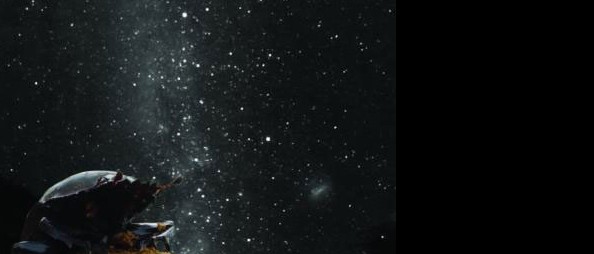Scientists have discovered that African dung beetles can use the Milky Way to help them navigate at night. The research was published on January 24, 2013 in the journal Current Biology.

Navigating at night can be very difficult for species that rely on visual cues to move around. Navigation tends to be easier when the moon is bright, but on moonless nights, things can get complicated.
An international team of scientists working in Africa were surprised to notice that a group of dung beetles still managed to navigate efficiently during moonless nights. They suspected that the beetles were using the starry sky as a navigational aid.
Dung beetles are known for rolling up balls of dung for later use as food. Once they collect the dung, the beetles quickly roll the ball away from the dung pile to avoid having it stolen by other beetles. They do this by moving in a straight line.
To test whether the beetles were using the stars as a navigational aid, scientists put the beetles into a dung-rolling course and filmed their behavior. The beetles were able to move in a straight line on moonlight nights and also on moonless nights when the Milky Way was visible. When the sky was overcast, the beetles were unable to roll the dung balls in a straight line. When the beetles had tiny visors taped onto their heads to block their view of the night sky, they spent their time wandering aimlessly.
Next, they tested their speed on a 2 meter platform. On nights when the Milky Way was visible, the beetles were able to cross the platform in as little as 40 seconds. On cloudy nights, it took the beetles nearly 2 minutes to cross the platform.
Lastly, scientists tested the beetles inside of a planetarium. The dung beetles moved more efficiently when the ground was lit by the light of the Milky Way. When the ground was lit by the light of only a few bright stars, the beetles performed worse.
This research is believed to be the first study to document the use of the Milky Way for orientation in the animal kingdom.
Marie Dacke, lead author of the study, is an Assistant Professor at Lund University in Sweden. Her current research is focused on gaining a better understanding of the nocturnal and diurnal navigational systems used by insects. She commented on the study’s findings in a press release:
Dung beetles are known to use celestial compass cues such as the sun, the moon, and the pattern of polarized light formed around these light sources to roll their balls of dung along straight paths. Celestial compass cues dominate straight-line orientation in dung beetles so strongly that, to our knowledge, this is the only animal with a visual compass system that ignores the extra orientation precision that landmarks can offer.
Other authors of the study included Emily Baird and Eric Warrant from Lund University in Sweden, Marcus Byrne from the University of Witwatersrand in South Africa and Clarke Scholtz from the University of Pretoria in South Africa.
Bradley Mullens, an entomologist at the University of California in Riverside who was not involved in the research, told the Los Angeles Times:
I would not be surprised if other nocturnal insects — or maybe other animal groups — might be able to use a diffuse but directional cue such as the Milky Way. Maybe this paper will stimulate more studies of that nature.
Bottom line: Scientists have discovered that African dung beetles use the Milky Way to help them navigate at night. This research is believed to be the first study to document the use of the Milky Way for orientation in the animal kingdom. The research was published on January 24, 2013 in the journal Current Biology.

Rare photo of aurora australis – southern lights – and bioluminescence











